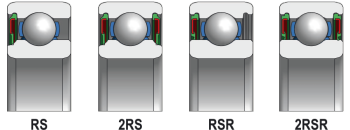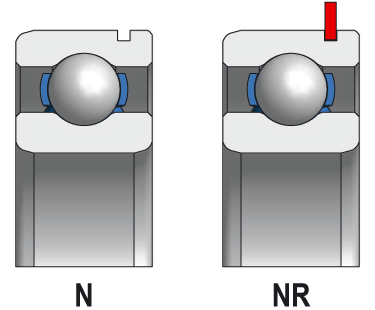
The single row deep groove ball bearings have relatively deep raceways on both rings without a filling slot and they are non-separable. By optimum size of balls and by their conformity to the raceways high load ratings are achieved.
They can carry axial and radial loads in both directions and are suitable even for high rotation speeds. These bearings are manufactured in a broad selection of types and are the most common rolling bearing type.

Main dimensions of single row deep groove ball bearings specified in the dimension tables are in accordance with the international standards ISO 15. Snap ring groove dimensions comply with the international standards ISO 464.

Single row deep groove ball bearings with sealing on one or on both sides are manufactured with metal shields (Z, -2Z, or ZR, -2ZR) or with seals (RS, -2RS or RSR, -2RSR). The shields create a non-contact sealing.
The bearings are manufactured in the original design with shoulders for shields on the inner ring (Z, -2Z) or in the new design with a shield and a flat collar of the inner ring (ZR, -2ZR).
The sealing rings made of rubber, vulcanized on metal reinforcing ring, provide an effective friction type sealing. The bearings are manufactured in the design with rounded shoulders on the inner ring (RS, -2RS) or in a new design with a seal and a flat collar of the inner ring (RSR, -2RSR). Bearings with seals are suitable for usage within the temperature range from -30°C to 110°C. Bearing deliveries with sealing capacity within 180°C (RS2, -2RS2, resp. RSR2, -2RSR2), or eventually delivery of bearings with other sealing design, must be negotiated in advance. Shields and seals are inserted in the recess of the outer ring and these are not removable.
Bearings sealed on both sides (-2Z, -2RS, or -2ZR, -2RSR) are filled with a quality grease the properties of which usually ensure the lubrication during the whole bearing life under normal operating conditions. The bearings of this design cannot be relubricated. They can be used within the operating temperature range from -30°C to 110°C. The delivery of bearings with different grease should be discussed with the supplier in advance.


For bearings sealed on both sides, the designation of the grease filling different from standard grease is indicated by a symbol combination. The first two letters indicate the operating temperature range (a symbol in accordance with STN 02 4608) and the third identifies the grease name.
TL – Grease for low operating temperatures (from -60°C to 100°C)
TM – Grease for medium operating temperatures (from -35°C to 140°C)
TH – Grease for high operating temperatures (from -30°C to 200°C)
TW – Grease for low and high operating temperatures (from -40°C to 150°C)
Note: The symbols of grease for medium operating temperatures need not to be marked on the bearings.
The single row deep groove ball bearings with a snap ring groove (N) can be easily axially fixed in the housings and without high requirements on the space simplifying the arrangement design. For bearings with a groove in the outer ring, snap rings corresponding to STN 02 4605 are used (commercial designation R and the number indicating the outside diameter D of the corresponding bearing, e. g. R47). Bearings with a snap ring groove and a snap ring are designated by the suffix NR, e. g. 6204NR. Snap rings for the bearings with a snap ring groove are delivered separately. The bearings with a snap ring groove can also be delivered in the modification with shields or seals (ZN, -2ZN or RSN, -2RSN). The delivery of these bearings must be discussed in advance.

For some less demanding arrangements, e. g. in agricultural machines, etc., some sizes of single row deep groove ball bearings of type 62 and 63 with a tapered bore (K), taper 1:12 are manufactured. These bearings are also manufactured in a design with shields on both sides. The bearings are fixed on the cylindrical shaft by means of adapter sleeves of types H2, H3 or directly on the tapered shaft.
The single row deep groove ball bearings of the basic design are equipped with a pressed cage made of steel sheet, guided on balls, which is not designated. Bearings can be shipped also with massive steel (mark: F), or with massive brass (mark: M), cage, guidance of which may be on balls or some of the rings. In special cases the bearings are produced with different types of cages: bearings with a solid polyamide cage (TNH, TNGH), with a solid cage of textite (TB). The supply of these bearings should be discussed in advance.
Single row deep groove ball bearings are produced in tolerance classes P0 and P6. For special arrangements requiring high precison or for arrangements with a high rotation speed, the bearings in higher tolerance classes P5 and P4 are used. The bearings in higher tolerance class P6E are used for rotating electric machines. The limit values of deviations in tolerances and the operation are specified in ISO 492.
Commonly produced single row deep groove ball bearings have normal radial clearance which is not indicated. In specific cases bearings with radial clearance C2 (smaller than normal clearance) or with the radial clearance C3, C4, C5 (greater than normal clearance) can be produced (ISO 5753).
Commonly manufactured single row ball bearings have a normal vibration level checked by the manufacturer. For special arrangements bearings with reduced vibration level (C6) are produced.
The symbols for the tolerance classes, internal bearing clearances and vibration levels are combined with the simultaneous omission of the symbol C for the second and the following special bearing characteristics e.g.:
For operating temperature higher than 120°C specially stabilized single row deep groove ball bearings with stabilized dimensions for operating temperature from 150°C to 400°C (S0, S1, S2, S3, S4,S5) are produced. Delivery of stabilized bearings should be discussed in advance.
For single row ball bearings only small mutual misalignment of bearing rings is permissible, therefore alignment deviation of seating surfaces can be very small. Misalignment causes additional load of the bearing and thus its life is shortened. Values of permissible misalignment at normal operating conditions are shown in the table.